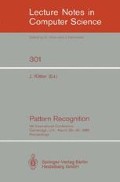Abstract
A method has been developed that can take a human description of an object's spatial appearance and produce a PROLOG representation. The object's appearance is currently in terms of an edge map and the English descriptions are stylised accounts of the salient features and combinations of features found in this representation. At present the translation is performed by hand. However, suggestions are made on how this process can be automated. A prototype translator has been implemented. The PROLOG model is expressed as a hierarchy about the object's appearance, terminating in plausible low-level image primitives. A way is proposed of matching the hierarchy against an image for object recognition in isolation from its background. This reduces the search space of features and feature combinations that the matcher has to consider, so avoiding some of the combinatorial problems when using PROLOG. Extensions using fuzzy logic to deal with uncertain image date and the vagueness of natural language are discussed.
British Crown Copyright, 1987
Preview
Unable to display preview. Download preview PDF.
References
Adorni, G., Di Manzo, M., Giunchiglia, F., Meson, L., October, 1984, “A conceptual approach to artificial vision”, Proc. of the 4th Int. Conf. on Robot Vision and Sensory Controls — RoVisSec 4, London.
Baldwin, J.F., 1986, “Support logic programming”, in Jones, A.I. et al (eds), “Fuzzy sets — Theory and Applications”, Proceedings of NATO Advanced Study Institute, Reidel Publishing Co..
Barrett, R., Ramsey, A., Sloman, A., 1985, “POP-11: A practical language for artificial intelligence”, Ellis Horwood, Chichester.
Clocksin, W.F. and Mellish, C.S., 1984, “Programming in PROLOG” (2nd edn), Springer-Verlag, Berlin.
Di Manzo, M., Adorni, G., Giunchiglia, F., Ricci, F., 1985, “Building function descriptions: Computer vision”, Proc. of the 5th Int. Conf. on Robot Vision and Sensory Controls — RoVisSec, Amsterdam, Netherlands, 29–31 Oct. 1985, pp403–412.
Fretwell, P., Hearn, D.B., Sleigh, A.C., 1986 “Methods for knowledge representation and inference for image understanding”, Oral Presentation at IEE Colloquium on Knowledge-based image processing, Savoy Place, London, 27 January 1986.
Fretwell, P., Goillau, P.J., Hearn, D.B. and Sleigh, A.C., 1987, “Representation and reasoning using linguistic descriptions of objects”, Oral Presentation at BPRA Colloquium on Representing knowledgein vision, Imperial College, London, 7 April 1987.
Fretwell, P., Bayliss, D.A., Radford, C.J., and Series, R.W., 1988, “Generic cueing in image understanding”, this volume.
Ingrand, F. and Latcombe, J.C., “Functional reasoning for automatic fixture design”, November, 1984, CAM-I 13th. Annual meeting and technical conference, Clearwater Beach, Florida.
Lowry, M.R., 1982, “Reasoning between structure and function”, Proceedings of the DARPA image understanding workshops, pages 260–264. Science Applications Inc., McLean, VA., September.
Pereira, F.C.N. and Warren, D.H.D., 1980, “Definite Clause Grammars for language analysis — a survey of the formalism and a comparison with Augmented Transition Networks”, Artificial Intelligence, 13, pp231–278.
Winograd, T., 1983, “Language as a Cognitive Process. Volume I: Syntax”, Addison-Wesley, Reading, Massachusetts.
Winston, P.H., Binford, T.O., Katze, B., and Lowry, M., 1983, “Learning physical descriptions from functional definitions, examples and precedents”, M.I.T. AI Memo, January 1983.
Author information
Authors and Affiliations
Editor information
Rights and permissions
Copyright information
© 1988 Springer-Verlag Berlin Heidelberg
About this paper
Cite this paper
Fretwell, P., Goillau, P.J. (1988). Linguistic definition of generic models in computer vision. In: Kittler, J. (eds) Pattern Recognition. PAR 1988. Lecture Notes in Computer Science, vol 301. Springer, Berlin, Heidelberg. https://doi.org/10.1007/3-540-19036-8_30
Download citation
DOI: https://doi.org/10.1007/3-540-19036-8_30
Published:
Publisher Name: Springer, Berlin, Heidelberg
Print ISBN: 978-3-540-19036-3
Online ISBN: 978-3-540-38947-7
eBook Packages: Springer Book Archive

